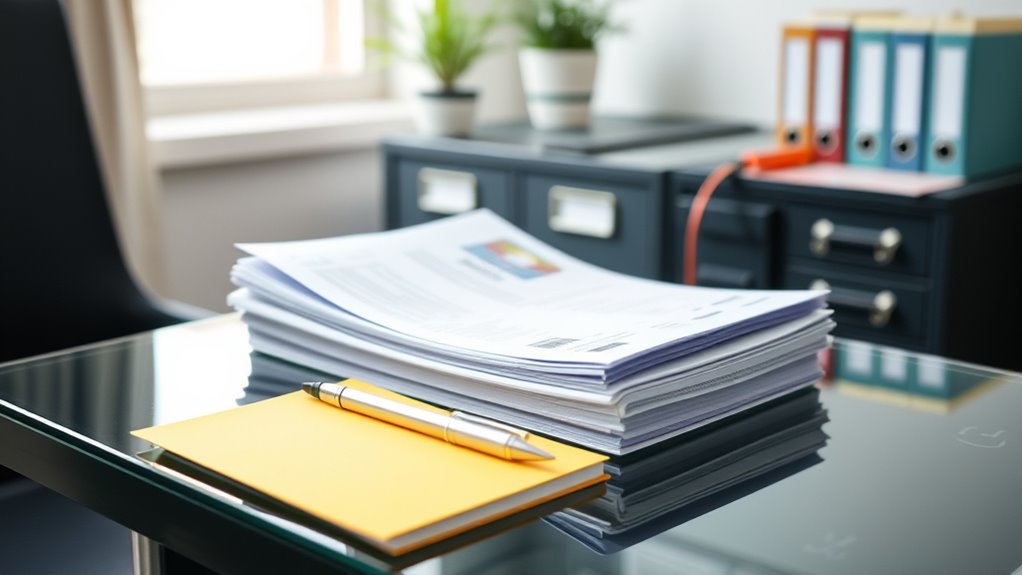Setting aside a budget buffer for end-of-lease surprises helps your business handle unexpected costs smoothly. Review lease terms for extra charges and estimate potential expenses based on past data. Allocate a contingency fund to cover hidden fees or damages, and adjust it regularly as costs arise. Having this reserve guarantees you won’t struggle financially if surprises occur at lease end or during operations. To learn more about creating an effective buffer, keep exploring these strategies.
Key Takeaways
- Establish a contingency fund based on historical lease and maintenance costs to cover unexpected end-of-lease expenses.
- Regularly review lease agreements for potential extra charges like damages, cleaning, or early termination fees.
- Monitor actual expenses against projections and adjust your buffer to ensure sufficient coverage for surprises.
- Allocate a percentage of your budget or a fixed amount as a safety net specifically for end-of-lease costs.
- Maintaining a well-funded buffer ensures financial stability and peace of mind during lease conclusion and property handover.

Have you ever wondered how to prevent unexpected expenses from derailing your financial plans? When it comes to managing business finances, one of the most effective strategies is to establish a budget buffer. This extra fund acts as a safety net, helping you handle surprises that can arise at the end of a lease or during ongoing operations. Leasing costs are often predictable, but sometimes, hidden fees or damages can unexpectedly inflate your final bill. By setting aside a designated amount for these potential charges, you ensure that your business remains financially stable, even when surprises happen. Similarly, maintenance expenses—whether routine or unforeseen—can catch you off guard if you’re not prepared. Regular upkeep is necessary to keep equipment and property in good condition, but repairs or replacements sometimes come with higher costs than anticipated. Having a budget buffer means you’re not caught off balance when these costs appear, allowing you to address them promptly without disrupting your cash flow.
Creating this buffer starts with an honest assessment of your current expenses and potential liabilities. Review your lease agreement carefully; some leases include clauses that might lead to additional charges, such as cleaning fees, damages, or early termination costs. Estimating these expenses and adding a contingency amount to your budget ensures you’re covered. When it comes to maintenance expenses, check historical data on past repairs and scheduled upkeep to gauge future costs. Add a percentage or fixed amount to your regular budget as a cushion for unexpected repairs or urgent fixes that may crop up. This way, you’re not caught unprepared if a piece of equipment breaks down or if property issues arise suddenly. Also, understanding the importance of regular expense monitoring can help you adjust your buffer efficiently over time.
Start with an honest review of your expenses and add contingency funds for unexpected costs.
A key part of setting up your budget buffer is monitoring your expenses regularly. Keep track of actual leasing costs and maintenance expenses against your projections. Adjust your buffer as needed—if you notice your costs are consistently higher, increase your reserve. Conversely, if your expenses are lower than expected, you might free up some funds for other priorities. Remember, the goal is to be proactive, not reactive. The more you anticipate potential costs, the less likely they are to disrupt your business operations.
Ultimately, a well-planned budget buffer provides peace of mind. It allows you to navigate end-of-lease surprises and ongoing maintenance expenses without stress or financial strain. By dedicating a small portion of your funds now, you safeguard your business’s stability and ensure smoother financial sailing, even when unexpected costs pop up.
Frequently Asked Questions
How Do I Determine the Right Size for My Budget Buffer?
To determine the right size for your budget buffer, analyze potential end-of-lease surprises like lease negotiations costs or unexpected insurance coverage expenses. Review your lease terms and past experiences to estimate possible charges. Add a contingency fund that covers these risks, ensuring you’re financially prepared. Adjust the buffer as needed based on lease complexity and the likelihood of unforeseen costs, so you stay protected without overspending.
What Are Common Unexpected End-Of-Lease Costs?
You might encounter a few unforeseen expenses at lease’s end, often due to lease penalties or hidden fees. These can include charges for excess wear and tear, early termination, or unanticipated cleaning costs. By staying vigilant and reviewing your lease agreement carefully, you can better prepare for these surprises. Setting aside a small reserve helps you handle lease penalties and hidden fees smoothly, ensuring you avoid financial strain during the final stages of your lease.
How Often Should I Review and Adjust My Budget Buffer?
You should review and adjust your budget buffer regularly, ideally every six months or before lease renewals. This way, you stay prepared for unexpected costs like deposit refunds or end-of-lease repairs. If you notice increased expenses or changes in lease terms, update your buffer accordingly. Staying proactive guarantees you’re financially ready for surprises, avoiding stress when it’s time for a lease renewal or handling deposit refunds.
Can a Budget Buffer Cover Damages Beyond Wear and Tear?
Imagine your budget buffer as a superhero cape, ready to save the day! While it can cover typical damages beyond wear and tear, extreme issues like major structural damage or a lease extension penalty might stretch it too thin. You should perform a thorough damage assessment before relying solely on your buffer, ensuring you’re prepared for unexpected costs that go beyond ordinary wear and tear.
What Strategies Minimize End-Of-Lease Surprises?
To minimize end-of-lease surprises, you should keep an eye on your lease renewal options and monitor vehicle depreciation regularly. Staying proactive helps you spot potential charges early, ensuring you address issues like excess wear and tear or damages before the lease ends. Regular maintenance and detailed documentation also reduce unexpected costs, giving you a clearer picture of your vehicle’s condition and avoiding surprises when it’s time to return or renew.
Conclusion
By setting aside a budget buffer, you’re not just preparing for the unexpected—you’re covering your bases and avoiding surprises that could blow your plans off course. Think of it as having a safety net ready to catch you when things go awry. Staying proactive with your finances means you won’t be caught with your pants down when lease-end surprises pop up. Remember, a little extra planning now can save you a lot of headaches later.










